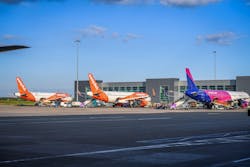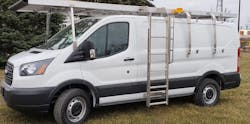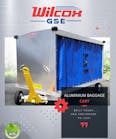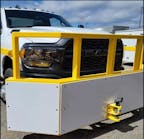Two years ago, Ground Support Worldwide spoke with London Luton Airport (LLA) to discuss the GSE pooling program it had recently implemented to reduce congestion on the ramp. Today, Liam Bolger, Luton’s head of airside, has given us an update on the program and best practices learned along the way.
“Well, it’s been going great and we’ve learned a lot since we started with this,” he begins. “I did not think it would have brought us to where we are today.”
The Top Three
In addition to the top three ground support handling companies LLA has running operations on its property: Menzies, Swissport and GH London (TCR International won the contract to provide and maintain the equipment), Bolger says there are three distinct benefits they’ve seen through the GSE pooling program.
Breaking Old Habits
“What became obvious is that there was no great management control on equipment and how it was used,” Bolger explains. “It was all behavioral, so one of the biggest challenges has been changing old habits.”
A major improvement in illegally parked equipment is just one example of this. Bolger says that the rollout began in January 2017, and in 2018, the team agreed to standardize the equipment restraint areas. During those years, the number of mis-parked equipment events dropped from 3,895 in 2016 to only 416 through the first three quarters of 2019.
“We are seeing an increase at the moment due to the 52 new electric baggage tugs and the 186 baggage trailers we introduced as part of Phase 2,” he adds. “This will take a bit of time to settle, however the reduction is pretty impressive.”
Gennaro Carcassa, head of the United Kingdom ground support operation for GH London, agrees with Bolger’s thoughts. He says benefits of the pooling have been seen in the lower amount of equipment sitting around the airport, as well as the noticeably high performance he’s seen in the turnaround of planes and the improved quality of service for inbound A/C services and offloading passengers.
Bolger also speaks to the changes in delays caused by equipment management issues.
“If I had an aircraft going at 6:30 a.m. I put equipment on it, but another handler may come along in the middle of the night and take that equipment off, putting it on another that was going out at 7:30 a.m.,” he explains.
Pre-pooling, the total delayed minutes for equipment was at its highest at 839 minutes in a month, averaging approximately 600. Since pooling, the lowest delayed total to date has been 83 minutes per month. The average today, Bolger says, is running about 105 minutes per month, a substantial improvement.
The electric baggage tractors added to the to the pool this year are contributing to that number.
“It’s just establishing new behaviors around the additional equipment,” Bolger points out, saying that this benefit of GSE pooling has been undeniable.
Safety
A massive 900-percent improvement in safety reporting is the icing on the cake. The reduction in safety incidents has also been significant as well. Bolger links this to the concept of breaking old habits.
“Safety is behavioral driven,” he explains. “GSE pooling led to a real focus on behaviors in general and we’ve seen a massive change.”
Carcassa also acknowledges that safety has improved with pooling, as he’s seen a reduction in the number of accidents and injuries.
Every aircraft that lands at LLA is now beginning to be turned in the same way. Bolger says the LTN Safety Stack Ground Operations Manual provides realistic, standardized procedures for turns, torqueing, combing and underwing activities. (Anyone operating airside is deemed a Stack Partner – another conversation.) How have the ground support providers responded?
“They understand things could be done better and each have their strong points, but we believe that good safety practices start with people knowing exactly what their role is for any aircraft,” Bolger explains.
Cost savings
What people don’t hear, Bolger explains, is the cost to ground support providers before pooling.
“They had guys towing equipment around every day,” he says. “They’re not having to do that anymore. They had people going out every day to carry out equipment checks and add fuel. All of those things are gone.”
Cost savings based on equipment uplift for peak schedules was also a benefit, as leasing contracts were being executed late February and through March for equipment not needed until May. Still, it took up space and money during those down times.
“The revenue stream now can be based on the turn of the aircraft,” he adds.
This has been effective, as Carcassa adds that additional benefits of pooling have been found in reduced fuel consumption, pollution and the initial investment needed to begin service.
The team at LLA has seen reduced usage on ground power units throughout 2018 resulting in a reduction in fuel usage of more than 40 percent and will probably see another 15 percent with updated telematics following a transfer to a more modern system provided by a new TCR-contracted company called Targa.
Bolger says that the goal is to design programs which will shut off equipment automatically when left running unnecessarily and off-load.
“This will do a lot more for us as we gain insight into how the equipment’s been used and how we can use it more efficiently in the future,” he adds.
Ironically, another cost-saving benefit comes in basic stress relief. The operation center previously fielded at least 60 calls a day from different ground service providers complaining about equipment. Today, that number has dramatically decreased and the center only receives one or two per month.
Bolger says there were days he struggled to see how this would ever get done, but never lost belief in the project.
“It was just about us all, even the ground handlers, being brave enough in the end to just go and do it, knowing it would work,” he says. “It was going to benefit everybody. If we were going to grow as a business, it just had to be done.”
Behind the Scenes
Now viewed worldwide as a GSE pooling expert and often asked for advice, Bolger says he first tells others that the charge to implement this practice must be led by the airport itself.
“The airports have to say they’re going to do this and make sure that the ground handling contracts are robust enough to cover ‘per performance,’” he says. “They need to know we’re going to not bring in more handlers but improve performance with the ones we have.”
He said the airport gathered all involved parties into a room, facilitated the legal work, set terms and let them decide equipment specifications because they knew what works best. The ground support providers decided on quantity for the pool, but the airport decided what actually made the cut.
They started with steps, power units, baggage belts and ancillaries – those pieces causing the biggest congestion headaches. Since then, electric baggage tugs and trailers have been added. The only thing not being shared today is pushback tractors, which will be going out to bid toward the end of next year as LLA prepares to renew the current contract through competitive tender.
TCR was appointed to supply all the equipment, which the ground handlers contract directly through them. This has worked well, as Bolger explains it’s not taking away a competitive advantage, just eliminating a lot of overhead headaches.
“They provide all equipment on very much a traditional lease model, however charging is on a price per turn at Luton,” Bolger adds. “The cost model is different and the reason we did price per turn is so that everybody pays the same. You won’t get a discount because you did more turns than somebody else. We have two major airlines and also smaller ones, so this approach makes it fair.”
Sharing equipment must be one of the defined contract terms, thoroughly explaining that everyone is using shared, standard equipment. The last three years of pooling equipment has really been an eye-opener, Bolger says, in terms of how much they really did have on the field, how much was being used and how.
“We now understand better what’s required and making use of them efficiently,” he adds.
“You need to come right out and say: ‘We can’t do this anymore. This is what we’re going to do instead.’ When you do that, you focus people’s mindset toward the project,” Bolger explains.
Cooperation
“They’ve been doing really great,” Bolger says of the three ground handling companies’ cooperation surrounding the pooling efforts.
In the past, corporate-level staff at the companies were skeptical, but that has changed too, according to Bolger.
“Their biggest fear was that if they had pooling, the access to the market was lower,” he explains. “I think what they needed to see was that airports don’t want more ground handlers. They just want better ones.”
The road to GSE pooling success has been paved with cooperation and communication, through weekly meetings with the front-line users to discuss just this practice. Bolger says it’s essential to keep communications strong with the senior managers on a monthly basis.
Hong Kong International Airport has taken on the pooling idea in force, while he says the United Kingdom and European airports are in talks. Bolger says eventually this practice will spread worldwide, with the mounting environmental pressures plus capacity issues airports are facing.
“There’s just no other way to do this than to get people to share,” he says. “There’s not enough room and they’re not going to be given more real estate for equipment. One of the goals when we began this journey was to improve margins for stretched ground handlers, I believe we have achieved that.”
In an industry where it’s been tough to make a profit the last five years, Bolger says this was a monumental change in thinking and execution, but has since transpired into a welcome one.
“If you spoke to everyone on the front line, they would just say it makes sense,” he comments. “Pooling is an open doorway to creating much greater relationships and improving safety and operations.”






